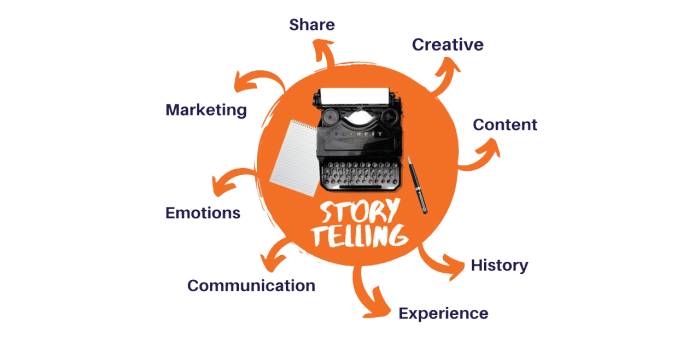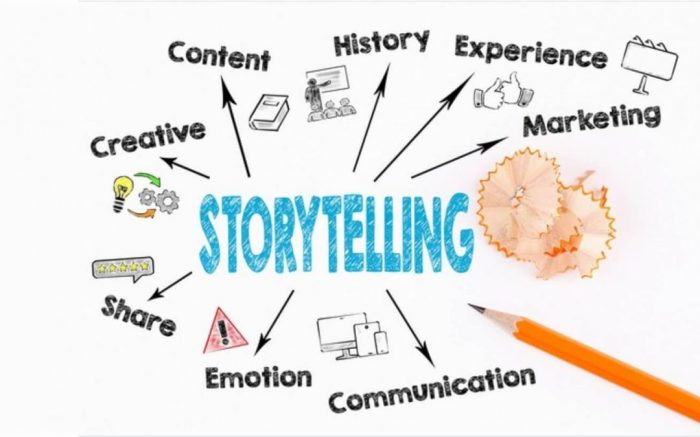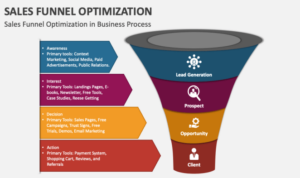With Effective Storytelling in Marketing at the forefront, this paragraph opens a window to an amazing start and intrigue, inviting readers to embark on a storytelling journey filled with unexpected twists and insights.
In the world of marketing, the ability to tell a captivating story can make all the difference between a successful campaign and a forgettable one. Effective storytelling has the power to connect with audiences on a deeper level, leaving a lasting impression that drives brand loyalty and engagement. By incorporating elements like characters, plot, and visuals, brands can create narratives that resonate with consumers and set themselves apart in a crowded marketplace.
Importance of Effective Storytelling in Marketing

Storytelling ain’t just for bedtime, folks! It’s a game-changer in the world of marketing. By weaving a compelling narrative, brands can capture the attention of their audience, stand out from the competition, and leave a lasting impression. Let’s dive into why effective storytelling is key in marketing.
Building Brand Identity
When it comes to marketing, it’s all about building that brand identity and connecting with your audience on a deeper level. Storytelling allows brands to showcase their values, mission, and personality in a way that resonates with customers. Take Nike, for example. Through their powerful “Just Do It” campaign, they’ve inspired millions with stories of perseverance and triumph.
Creating Emotional Connections
Storytelling has the magical ability to tug at the heartstrings of consumers. By crafting narratives that evoke emotions like joy, nostalgia, or even empathy, brands can form strong emotional connections with their audience. Dove’s “Real Beauty” campaign is a prime example of how storytelling can empower and uplift customers by celebrating diverse beauty.
Standing Out in a Crowded Market
In a sea of ads and promotions, storytelling is the secret sauce that helps brands stand out. When you tell a captivating story that resonates with your audience, you’re more likely to cut through the noise and leave a lasting impression. Think of Coca-Cola’s iconic holiday campaigns, which have become synonymous with spreading cheer and goodwill.Storytelling isn’t just a trend—it’s a powerful tool that can elevate your marketing game and set your brand apart from the rest.
So, grab your pen, craft your narrative, and let your story unfold in the hearts and minds of your audience.
Elements of Effective Storytelling in Marketing
Effective storytelling in marketing involves various key elements that help capture the audience’s attention and create a lasting impact. Let’s delve into the essential components that make marketing storytelling successful.
Characters, Plot, and Conflict
In marketing storytelling, just like in any other form of storytelling, characters play a crucial role. These characters can be the brand itself, the customers, or even a relatable spokesperson. The plot is the sequence of events that unfold, leading to a resolution or outcome. Conflict is what drives the story forward and creates tension, making the narrative more engaging for the audience.
Authenticity and Relatability
Authenticity is key in marketing storytelling as it helps build trust with the audience. By being genuine and transparent, brands can connect with customers on a deeper level. Relatability is also important as it allows customers to see themselves in the story, making it more personal and relevant to their lives.
Incorporating Visuals and Multimedia
Visual elements such as images, videos, and infographics can enhance the storytelling experience in marketing. These visuals help bring the story to life, making it more engaging and memorable for the audience. By incorporating multimedia elements, brands can create a multi-sensory experience that resonates with customers on a deeper level.
Strategies for Implementing Storytelling in Marketing

To effectively implement storytelling in marketing, it is crucial to create a compelling brand story, understand the target audience, and align storytelling with the brand’s values and mission.
Creating a Compelling Brand Story
One of the key tips for creating a compelling brand story is to focus on authenticity. Your story should resonate with your audience and evoke emotions that connect them to your brand. Use a narrative structure that captivates your audience from the beginning to the end, making them feel like a part of the story.
Understanding the Target Audience in Storytelling
Understanding your target audience is essential in storytelling as it helps tailor your message to resonate with them. Conduct thorough research to identify their needs, preferences, and pain points. By knowing your audience, you can create stories that speak directly to them and establish a deeper connection.
Aligning Storytelling with Brand Values and Mission
It is vital to align your storytelling with your brand’s values and mission to maintain consistency and authenticity. Your stories should reflect the core beliefs and objectives of your brand, reinforcing what you stand for. By staying true to your values, you can build trust and credibility with your audience.
Measuring the Impact of Storytelling in Marketing: Effective Storytelling In Marketing
When it comes to measuring the impact of storytelling in marketing, there are several key metrics and tools that marketers use to evaluate effectiveness. By analyzing these metrics, companies can determine the success of their storytelling efforts and make informed decisions on future marketing strategies.
Metrics and Tools for Evaluating Storytelling Effectiveness, Effective Storytelling in Marketing
- Engagement Metrics: Tracking metrics such as time spent on a webpage, click-through rates, and social media shares can provide insights into how engaging the storytelling content is.
- Conversion Rates: Monitoring conversion rates from storytelling campaigns can help assess the impact on driving customer actions, such as making a purchase or signing up for a service.
- Brand Sentiment Analysis: Using tools to analyze customer sentiment towards the brand before and after storytelling campaigns can reveal changes in perception and brand favorability.
- Customer Feedback: Collecting feedback directly from customers through surveys, reviews, and social media comments can offer valuable insights into the effectiveness of storytelling in marketing.
Examples of Successful Marketing Campaigns
- Apple’s “Shot on iPhone” campaign: By featuring user-generated photos and videos captured on iPhones, Apple effectively told the story of the quality of its camera technology, leading to increased brand loyalty and product sales.
- Coca-Cola’s “Share a Coke” campaign: Personalizing Coke bottles with individual names created a sense of connection and storytelling around sharing moments with loved ones, resulting in a significant boost in sales and social media engagement.
Influence of Storytelling on Brand Perception and Customer Engagement
Storytelling plays a crucial role in shaping brand perception and driving customer engagement. By crafting compelling narratives that resonate with their target audience, companies can create emotional connections and build brand loyalty. Customers are more likely to remember and connect with brands that tell authentic stories that evoke emotions and values they identify with, leading to increased customer engagement and loyalty over time.


